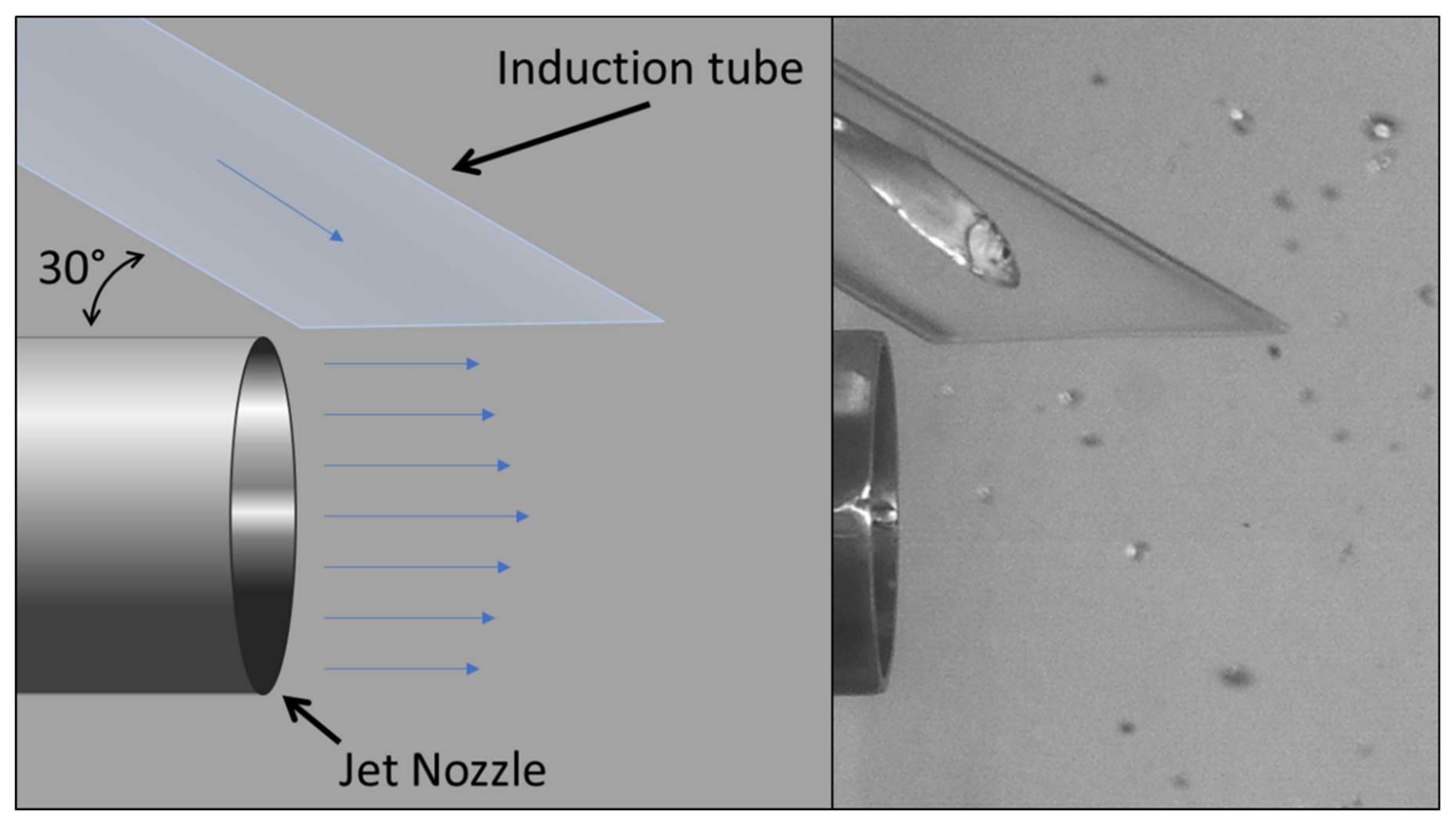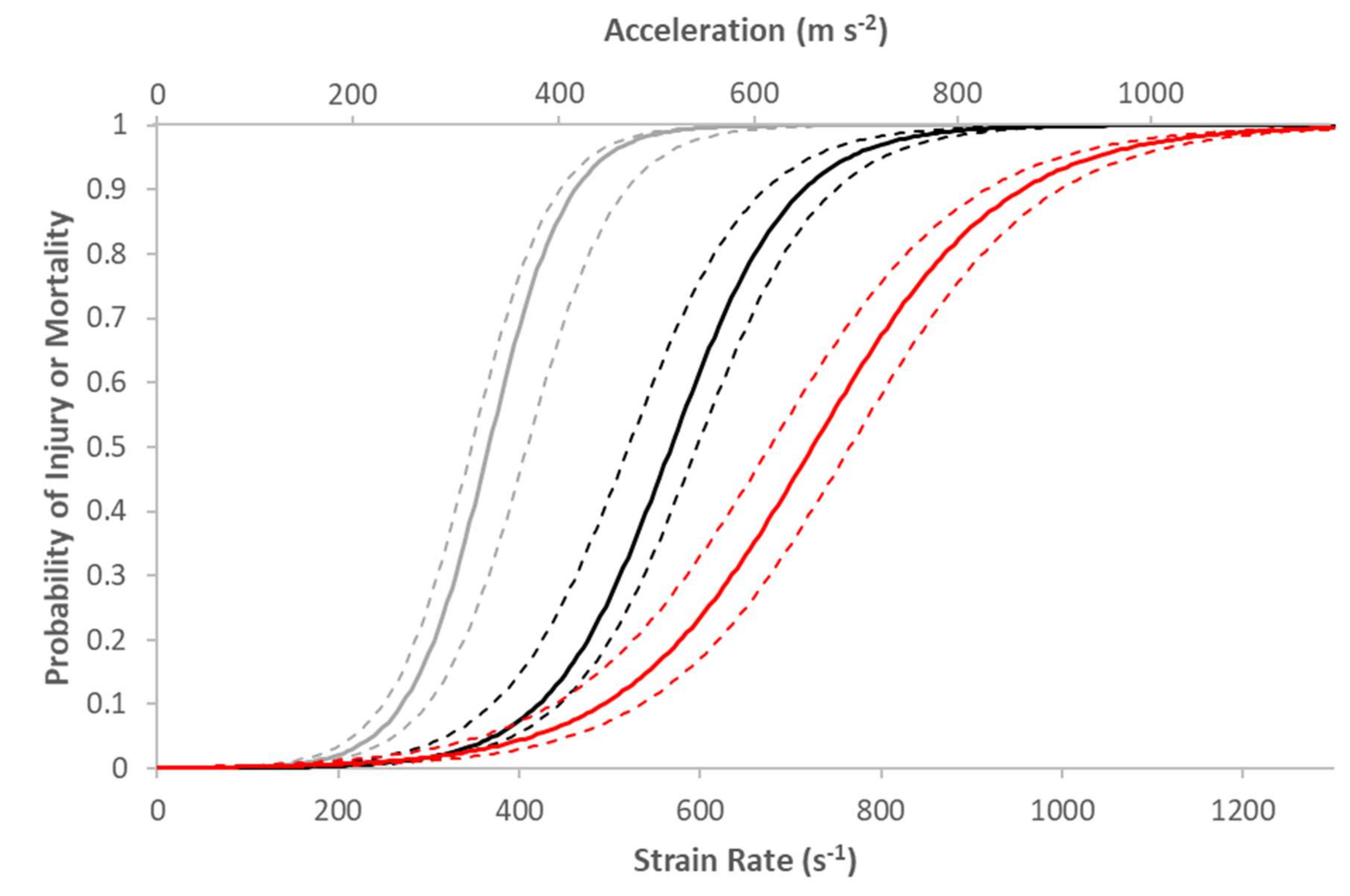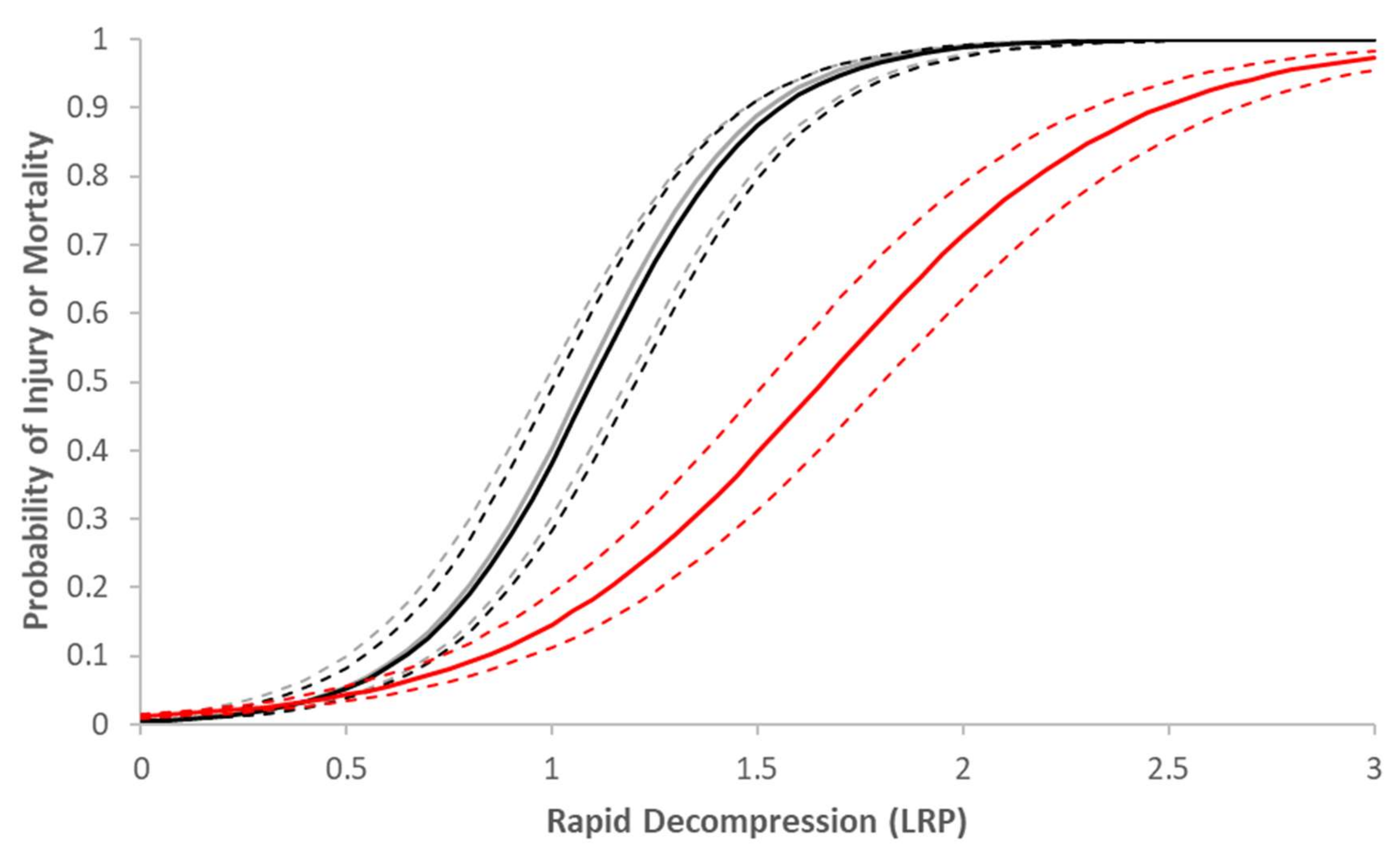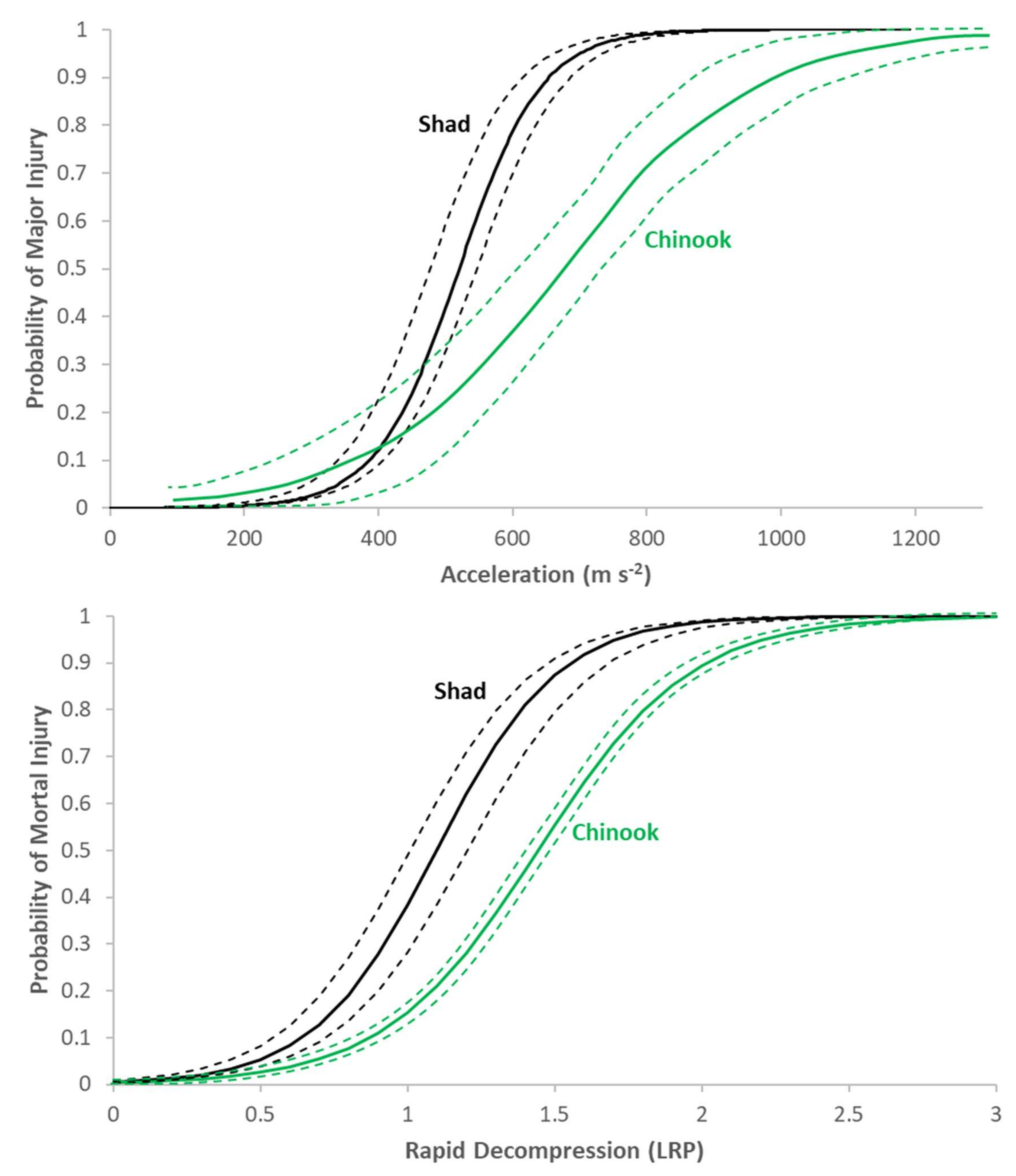The Susceptibility of Juvenile American Shad to Rapid Decompression and Fluid Shear Exposure Associated with Simulated Hydroturbine Passage
Abstract
1. Introduction
2. Methods
2.1. Fish Acquisition
2.2. Fluid Shear
2.2.1. Exposure to Fluid Shear
2.2.2. Fluid Shear Assessment
2.3. Rapid Decompression
2.3.1. Exposure to Rapid Decompression
2.3.2. Rapid Decompression Assessment
2.4. Analysis
3. Results
3.1. Fluid Shear
3.2. Rapid Decompression
3.2.1. Mortal Injury
3.2.2. Susceptibility to Rapid Decompression
4. Discussion
4.1. Fluid Shear
4.2. Rapid Decompression
5. Conclusions
Author Contributions
Funding
Acknowledgments
Conflicts of Interest
References
- Beasley, C.A.; Hightower, J.E. Effects of a low-head dam on the distribution and characteristics of spawning habitat used by striped bass and American shad. Trans. Am. Fish. Soc. 2000, 129, 1316–1330. [Google Scholar] [CrossRef]
- Collette, B.B.; Klein-Macphee, G. Bigelow and Schroeder’s Fishes of the Gulf of Maine, 3rd ed.; Smithsonian Institution Press: Washington, DC, USA, 2002. [Google Scholar]
- Cummins, J. A Compilation of Historical Perspectives on the Natural History and Abundance of American Shad and Other Herring in the Potomac River; The Interstate Commission on the Potomac River Basin: Rockville, MD, USA, 2011.
- Hawkins, J.H. Investigations of Anadromous Fishes of the Neuse River, North Carolina; North Carolina Department of Natural Resources and Community Development, Division of Marine Fisheries: Morehead City, NC, USA, 1980.
- Walburg, C.H.; Nichols, P.R. Biology and Management of the American Shad and Status of the Fisheries, Atlantic Coast of the United States, 1960; US Department of the Interior, Bureau of Commercial Fisheries: Washington, DC, USA, 1967.
- Greene, K.E.; Zimmerman, J.L.; Laney, R.W.; Thomas-Blate, J.C. Atlantic Coast Diadromous Fish Habitat: A Review of Utilization, Threats, Recommendations for Conservation, and Research Needs; Series No. 9; Atlantic States Marine Fisheries Commission Habitat Management: Washington, DC, USA, 2009.
- Lower Columbia Salmon and Steelhead Recovery and Sub-Basin Plan; Lower Columbia Fish Recovery Board: Vancouver, WA, USA, 2004.
- Stich, D.S.; Sheehan, T.F.; Zydlewski, J.D. A dam passage performance standard model for American shad. Can. J. Fish. Aquat. Sci. 2018, 76, 762–779. [Google Scholar] [CrossRef]
- Columbia Basin Research. Columbia River DART. Available online: http://www.cbr.washington.edu/dart/ (accessed on 26 November 2019).
- Hasselman, D.J.; Limburg, K.E. Alosine restoration in the 21st century: Challenging the status quo. Mar. Coast. Fish. 2012, 4, 174–187. [Google Scholar] [CrossRef]
- Limburg, K.E.; Waldman, J.R. Dramatic declines in north Atlantic diadromous fishes. Bioscience 2009, 59, 955–965. [Google Scholar] [CrossRef]
- Nack, C.C.; Swaney, D.P.; Limburg, K.E. Historical and projected changes in spawning phenologies of American shad and striped bass in the Hudson river estuary. Mar. Coast. Fish. 2019, 11, 271–284. [Google Scholar] [CrossRef]
- Amendment 1 to the Interstate Fishery Management Plan for Shad and River Herring; Atlantic States Marine Fisheries Commission: Arlington, VA, USA, 1999.
- Mulligan, K.; Haro, A.; Towler, B.; Sojkowski, B.; Noreika, J. Fishway entrance gate experiments with adult American shad. Water Resour. Res. 2019. [Google Scholar] [CrossRef]
- Hilton, E.J.; Latour, R.; McGrath, P.E.; Watkins, B.; Magee, A. Monitoring the Abundance of American Shad and River Herring in Virginia’s Rivers—2017 Annual Report; Virginia Institute of Marine Science, College of William and Mary: Williamsburg, VA, USA, 2018. [Google Scholar] [CrossRef]
- Talbot, G.B. Factors Associated with Fluctuations in Abundance of Hudson River Shad; US Government Printing Office: Washington, DC, USA, 1954.
- Walburg, C.H.; Fish, U.S.; Wildlife, S. Relative Abundance of Maryland Shad, 1944–1952; U.S. Department of the Interior, Fish and Wildlife Service: Washington, DC, USA, 1955; p. 17.
- Williams, R.O. Investigations on American Shad in the St. Johns River; Marine Research Laboratory Technical Series; Florida Department of Natural Resources: St. Petersburg, FL, USA, 1972.
- Bell, C.E.; Kynard, B. Mortality of adult American shad passing through a 17-megawatt Kaplan turbine at a low-head hydroelectric dam. N. Am. J. Fish. Manag. 1985, 5, 33–38. [Google Scholar] [CrossRef]
- Castro-Santos, T.; Letcher, B.H. Modeling migratory energetics of Connecticut River American shad (Alosa sapidissima): Implications for the conservation of an iteroparous anadromous fish. Can. J. Fish. Aquat. Sci. 2010, 67, 806–830. [Google Scholar] [CrossRef]
- Naughton, G.P.; Caudill, C.C.; Keefer, M.L.; Bjornn, T.C.; Stuehrenberg, L.C.; Peery, C.A. Late-season mortality during migration of radio-tagged adult sockeye salmon (Oncorhynchus nerka) in the Columbia River. Can. J. Fish. Aquat. Sci. 2005, 62, 30–47. [Google Scholar] [CrossRef]
- Rand, P.S.; Hinch, S.G. Swim speeds and energy use of upriver-migrating sockeye salmon (Oncorhynchus nerka): Simulating metabolic power and assessing risk of energy depletion. Can. J. Fish. Aquat. Sci. 1998, 55, 1832–1841. [Google Scholar] [CrossRef]
- Čada, G.F. A review of studies relating to the effects of propeller-type turbine passage on fish early life stages. N. Am. J. Fish. Manag. 1990, 10, 418–426. [Google Scholar] [CrossRef]
- Colotelo, A.H.; Pflugrath, B.D.; Brown, R.S.; Brauner, C.J.; Mueller, R.P.; Carlson, T.J.; Deng, Z.D.; Ahmann, M.L.; Trumbo, B.A. The effect of rapid and sustained decompression on barotrauma in juvenile brook lamprey and Pacific lamprey: Implications for passage at hydroelectric facilities. Fish. Res. 2012, 129, 17–20. [Google Scholar] [CrossRef]
- Kynard, B.; O’Leary, J. Evaluation of a bypass system for spent American shad at Holyoke dam, Massachusetts. N. Am. J. Fish. Manag. 1993, 13, 782–789. [Google Scholar] [CrossRef]
- Čada, G.F. The development of advanced hydroelectric turbines to improve fish passage survival. Fisheries 2001, 26, 14–23. [Google Scholar] [CrossRef]
- Cada, G.F.; Garrison, L.A.; Fisher, R.K. Determining the effect of shear stress on fish mortality during turbine passage. Hydro Rev. 2007, 26, 52. [Google Scholar]
- Čada, G.F.; Loar, J.; Garrison, L.; Fisher, R., Jr.; Neitzel, D. Efforts to reduce mortality to hydroelectric turbine-passed fish: Locating and quantifying damaging shear stresses. Environ. Manag. 2006, 37, 898–906. [Google Scholar] [CrossRef]
- Pflugrath, B. Quantifying Stressors and Predicting Injury and Mortality in Fish Passing Downstream Through Weirs and Turbines; University of New South Wales: Sydney, New South Wales, Australia, 2017. [Google Scholar]
- Neitzel, D.A.; Dauble, D.D.; Čada, G.F.; Richmond, M.C.; Guensch, G.R.; Mueller, R.P.; Abernethy, C.S.; Amidan, B.G. Survival estimates for juvenile fish subjected to a laboratory-generated shear environment. Trans. Am. Fish. Soc. 2004, 133, 447–454. [Google Scholar] [CrossRef]
- Brown, R.S.; Carlson, T.J.; Gingerich, A.J.; Stephenson, J.R.; Pflugrath, B.D.; Welch, A.E.; Langeslay, M.J.; Ahmann, M.L.; Johnson, R.L.; Skalski, J.R.; et al. Quantifying mortal injury of juvenile Chinook salmon exposed to simulated hydro-turbine passage. Trans. Am. Fish. Soc. 2012, 141, 147–157. [Google Scholar] [CrossRef]
- Deng, Z.; Carlson, T.J.; Duncan, J.P.; Richmond, M.C.; Dauble, D.D. Use of an autonomous sensor to evaluate the biological performance of the advanced turbine at Wanapum Dam. J. Renew. Sustain. Energy 2010, 2, 053104. [Google Scholar] [CrossRef]
- Brown, R.S.; Pflugrath, B.D.; Colotelo, A.H.; Brauner, C.J.; Carlson, T.J.; Deng, Z.D.; Seaburg, A.G. Pathways of barotrauma in juvenile salmonids exposed to simulated hydrotrubine passage: Boyle’s law vs Henry’s law. Fish. Res. 2012, 121, 43–50. [Google Scholar] [CrossRef]
- Pflugrath, B.D.; Boys, C.A.; Cathers, B. Predicting hydraulic structure-induced barotrauma in Australian fish species. Mar. Freshw. Res. 2018, 69, 1954–1961. [Google Scholar] [CrossRef]
- Brown, R.S.; Colotelo, A.H.; Pflugrath, B.D.; Boys, C.A.; Baumgartner, L.J.; Deng, Z.D.; Silva, L.G.M.; Brauner, C.J.; Mallen-Cooper, M.; Phonekhampeng, O.; et al. Understanding barotrauma in fish passing hydro structures: A global strategy for sustainable development of water resources. Fisheries 2014, 39, 108–122. [Google Scholar] [CrossRef]
- Pflugrath, B.D.; Harnish, R.; Rhode, B.; Beirao, B.; Engbrecht, K.; Stephenson, J.R.; Colotelo, A.H. American eel state of buoyancy and barotrauma susceptibility associated with hydroturbine passage. Knowl. Manag. Aquat. Ecosyst. 2019, 420, 20. [Google Scholar] [CrossRef]
- Deng, Z.D.; Guensch, G.R.; McKinstry, C.A.; Mueller, R.P.; Dauble, D.D.; Richmond, M.C. Evaluation of fish-injury mechanisms during exposure to turbulent shear flow. Can. J. Fish. Aquat. Sci. 2005, 62, 1513–1522. [Google Scholar] [CrossRef]
- Deng, Z.D.; Lu, J.; Myjak, M.J.; Martinez, J.J.; Tian, C.; Morris, S.J.; Carlson, T.J.; Zhou, D.; Hou, H. Design and implementation of a new autonomous sensor fish to support advanced hydropower development. Rev. Sci. Instrum. 2014, 85, 115001. [Google Scholar] [CrossRef] [PubMed]
- Stephenson, J.R.; Gingerich, A.J.; Brown, R.S.; Pflugrath, B.D.; Deng, Z.; Carlson, T.J.; Langeslay, M.J.; Ahmann, M.L.; Johnson, R.L.; Seaburg, A.G. Assessing barotrauma in neutrally and negatively buoyant juvenile salmonids exposed to simulated hydro-turbine passage using a mobile aquatic barotrauma laboratory. Fish. Res. 2010, 106, 271–278. [Google Scholar] [CrossRef]
- Pflugrath, B.D.; Brown, R.S.; Carlson, T.J. Maximum neutral buoyancy depth of juvenile Chinook salmon: Implications for survival during hydroturbine passage. Trans. Am. Fish. Soc. 2012, 141, 520–525. [Google Scholar] [CrossRef]
- McKinstry, C.A.; Carlson, T.J.; Brown, R.S. Derivation of a Mortal Injury Metric for Studies of Rapid Decompression of Depth-Acclimated Physostomous Fish; Pacific Northwest National Laboratory: Richland, WA, USA, 2007; PNNL-17080.
- Hogan, T.W.; Cada, G.F.; Amaral, S.V. The status of environmentally enhanced hydropower turbines. Fisheries 2014, 39, 164–172. [Google Scholar] [CrossRef]
- Trumbo, B.A.; Ahmann, M.L.; Renholds, J.F.; Brown, R.S.; Colotelo, A.H.; Deng, Z.D. Improving hydroturbine pressures to enhance salmon passage survival and recovery. Rev. Fish Biol. Fish. 2013, 24, 955–965. [Google Scholar] [CrossRef]
- Richmond, M.C.; Serkowski, J.A.; Rakowski, C.; Strickler, B.; Weisbeck, M.; Dotson, C. Computational tools to assess turbine biological performance. Hydro Rev. 2014, 33, 88–97. [Google Scholar]
- Bevelhimer, M.S.; DeRolph, C.R. Market Assessment for Hydropower Turbine Design Tools Using Integrated Datasets of Dams, Turbines, Owners, and Fish; Oak Ridge National Laboratory: Oak Ridge, TN, USA, 2019.
- Endangered Species Act; 16 US.C. §1531; US Fish and Wildlife Service: Washington, DC, USA, 1973.
- Abernethy, C.S.; Amidan, B.G.; Čada, G.F. Laboratory Studies of the Effects of Pressure and Dissolved Gas Supersaturation on Turbine-Passed Fish; Pacific Northwest National Laboratory: Richland, WA, USA, 2001; PNNL-13470.
- Schulz-Mirbach, T.; Heß, M.; Metscher, B.D.; Ladich, F. A unique swim bladder-inner ear connection in a teleost fish revealed by a combined high-resolution microtomographic and three-dimensional histological study. BMC Boil. 2013, 11, 75. [Google Scholar] [CrossRef]
- Mann, D.A.; Lu, Z.; Hastings, M.C.; Popper, A.N. Detection of ultrasonic tones and simulated dolphin echolocation clicks by a teleost fish, the American shad (alosa sapidissima). J. Acoust. Soc. Am. 1998, 104, 562–568. [Google Scholar] [CrossRef] [PubMed]
- Mann, D.A.; Lu, Z.; Popper, A.N. A clupeid fish can detect ultrasound. Nature 1997, 389, 341. [Google Scholar] [CrossRef]
- Mann, D.A.; Higgs, D.M.; Tavolga, W.N.; Souza, M.J.; Popper, A.N. Ultrasound detection by clupeiform fishes. J. Acoust. Soc. Am. 2001, 109, 3048–3054. [Google Scholar] [CrossRef]
- Popper, A.N.; Plachta, D.T.; Mann, D.A.; Higgs, D. Response of clupeid fish to ultrasound: A review. ICES J. Mar. Sci. 2004, 61, 1057–1061. [Google Scholar] [CrossRef]
- Astrup, J. Ultrasound detection in fish—A parallel to the sonar-mediated detection of bats by ultrasound-sensitive insects? Comp. Biochem. Physiol. Part A Mol. Integr. Physiol. 1999, 124, 19–27. [Google Scholar] [CrossRef]




| Jet Velocity (m s−1) | Strain Rate (s−1) | Acceleration (m s−2) | n | Length (mm) | |
|---|---|---|---|---|---|
| Median | Range | ||||
| 0 | 0 | 0 | 60 | 63 | 53–79 |
| 3 | 167 | 153.1 | 60 | 63 | 54–81 |
| 6 | 333 | 306.2 | 60 | 62 | 55–77 |
| 9 | 500 | 459.4 | 60 | 60 | 55–81 |
| 12 | 677 | 612.5 | 60 | 60 | 53–85 |
| 15 | 833 | 765.6 | 60 | 61 | 55–80 |
| 18 | 1000 | 918.7 | 60 | 64 | 55–76 |
| Jet Velocity (m s−1) | Normal | Loss of Equilibrium | Erratic |
|---|---|---|---|
| 0 | 60 (100%) | 0 (0%) | 0 (0%) |
| 3 | 60 (100%) | 0 (0%) | 0 (0%) |
| 6 | 58 (97%) | 1 (2%) | 1 (2%) |
| 9 | 56 (93%) | 3 (5%) | 1 (2%) |
| 12 | 47 (78%) | 5 (8%) | 8 (13 %) |
| 15 | 22 (37%) | 15 (25%) | 23 (38%) |
| 18 | 4 (7%) | 47 (78%) | 9 (15%) |
| Jet Velocity (m s−1) | n Descaled | Mean Descaling (%) | Injuries at Various Locations | Bruises/ Cuts | Minor Injury | Major Injury | Mortality | |||
|---|---|---|---|---|---|---|---|---|---|---|
| Eyes | Operculum | Gills | Isthmus | |||||||
| 0 | 0 (0%) | 0.0 | 0 (0%) | 0 (0%) | 0 (0%) | 0 (0%) | 0 (0%) | 0 (0%) | 0 (0%) | 1 (2%) |
| 3 | 0 (0%) | 0.0 | 0 (0%) | 0 (0%) | 0 (0%) | 0 (0%) | 0 (0%) | 0 (0%) | 0 (0%) | 1 (2%) |
| 6 | 15 (25%) | 0.7 | 0 (0%) | 2 (3%) | 0 (0%) | 0 (0%) | 0 (0%) | 16 (27%) | 2 (3%) | 2 (3%) |
| 9 | 60 (100%) | 8.8 | 2 (3%) | 6 (10%) | 0 (0%) | 0 (0%) | 2 (3%) | 60 (100%) | 23 (38%) | 5 (8%) |
| 12 | 58 (97%) | 17.1 | 14 (23%) | 19 (32%) | 0 (0%) | 2 (3%) | 0 (0%) | 58 (97%) | 48 (80%) | 21 (35%) |
| 15 | 60 (100%) | 38.2 | 29 (48%) | 26 (43%) | 0 (0%) | 8 (13 %) | 4 (7%) | 60 (100%) | 60 (100%) | 42 (70%) |
| 18 | 60 (100%) | 54.4 | 51 (85%) | 41 (68%) | 0 (0%) | 15 (25%) | 8 (13 %) | 60 (100%) | 60 (100%) | 60 (100%) |
| Endpoint | Strain Rate (s−1) | Acceleration (m s−2) | ||
|---|---|---|---|---|
| β0 | β1 | β0 | β1 | |
| Minor Injury | −8.418 | 0.023 | −8.520 | 0.025 |
| Major Injury | −8.515 | 0.015 | −8.773 | 0.017 |
| Mortality | −6.877 | 0.010 | −6.817 | 0.010 |
| Injury | Odds Ratio | Fisher’s Exact p-Value | Regression p-Value |
|---|---|---|---|
| Swim bladder rupture | 65.2 | 1.80E-59 | <0.001 |
| Renal hemorrhaging | 24.3 | 3.00E-17 | <0.001 |
| Right eye emphysema * | 24.1 | 2.00E-21 | |
| Exopthalmia † | 22.6 | 4.00E-16 | 0.001 |
| Eye emphysema * | 21.3 | 5.40E-24 | |
| Posterior renal embolism ‡ | 19.3 | 0.0004 | |
| Left eye emphysema * | 18.6 | 5.40E-20 | |
| Pectoral fin emphysema * | 17.6 | 1.20E-08 | |
| Mild gill embolism ‡ | 14.9 | 2.20E-05 | |
| Anal fin emphysema * | 13.2 | 5.40E-08 | |
| Renal embolism ‡ | 12.2 | 4.10E-11 | 0.044 |
| Fin emphysema * | 12 | 5.90E-14 | |
| Dorsal fin emphysema * | 11.7 | 9.90E-06 | 0.033 |
| Anterior renal embolism ‡ | 11.7 | 9.90E-06 | |
| Mid renal embolism ‡ | 9.9 | 5.80E-07 | |
| Pelvic fin emphysema * | 9.4 | 0.0317 | |
| Left eye hemorrhaging | 8.8 | 4.80E-10 | |
| Right eye hemorrhaging | 8.6 | 5.50E-11 | 0.003 |
| Gill embolism ‡ | 8.1 | 9.00E-05 | |
| Eye hemorrhaging | 7.9 | 4.40E-13 | |
| Intestinal hemorrhaging | 5.0 | 0.0003 | |
| Hepatic hemorrhaging | 4.8 | 0.0096 | |
| External signs of internal hemorrhaging | 3.1 | 0.0082 |
| Endpoint | β0 | β1 |
|---|---|---|
| Injury | −5.301 | 4.921 |
| Mortal Injury | −5.301 | 4.825 |
| Immediate Mortality | −3.851 | 2.349 |
© 2020 by the authors. Licensee MDPI, Basel, Switzerland. This article is an open access article distributed under the terms and conditions of the Creative Commons Attribution (CC BY) license (http://creativecommons.org/licenses/by/4.0/).
Share and Cite
Pflugrath, B.D.; Harnish, R.A.; Rhode, B.; Engbrecht, K.; Beirão, B.; Mueller, R.P.; McCann, E.L.; Stephenson, J.R.; Colotelo, A.H. The Susceptibility of Juvenile American Shad to Rapid Decompression and Fluid Shear Exposure Associated with Simulated Hydroturbine Passage. Water 2020, 12, 586. https://doi.org/10.3390/w12020586
Pflugrath BD, Harnish RA, Rhode B, Engbrecht K, Beirão B, Mueller RP, McCann EL, Stephenson JR, Colotelo AH. The Susceptibility of Juvenile American Shad to Rapid Decompression and Fluid Shear Exposure Associated with Simulated Hydroturbine Passage. Water. 2020; 12(2):586. https://doi.org/10.3390/w12020586
Chicago/Turabian StylePflugrath, Brett D., Ryan A. Harnish, Briana Rhode, Kristin Engbrecht, Bernardo Beirão, Robert P. Mueller, Erin L. McCann, John R. Stephenson, and Alison H. Colotelo. 2020. "The Susceptibility of Juvenile American Shad to Rapid Decompression and Fluid Shear Exposure Associated with Simulated Hydroturbine Passage" Water 12, no. 2: 586. https://doi.org/10.3390/w12020586
APA StylePflugrath, B. D., Harnish, R. A., Rhode, B., Engbrecht, K., Beirão, B., Mueller, R. P., McCann, E. L., Stephenson, J. R., & Colotelo, A. H. (2020). The Susceptibility of Juvenile American Shad to Rapid Decompression and Fluid Shear Exposure Associated with Simulated Hydroturbine Passage. Water, 12(2), 586. https://doi.org/10.3390/w12020586





